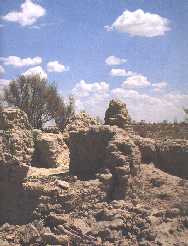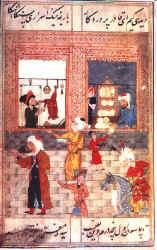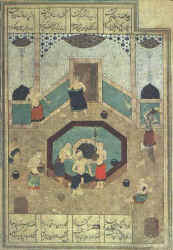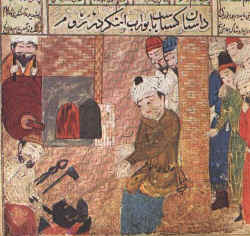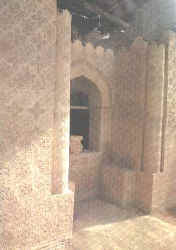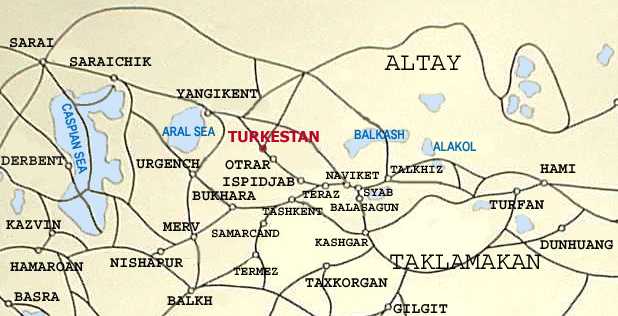|
|
|
SILK ROAD |
|
The
Silk Road is a system of ancient caravan routes leading from China to
the countries of the Near East and Europe. It is one of the most
important achievements in the history of world civilization. The
Silk Road is a historical route without a juridical status, transcending
many national borders. Hundreds of big and small towns fallen into
oblivion or still in existence witness to grandeur of the Silk Road.
The
Great Silk as a trade route was not unchangeable and stable route. As
time went on, some parts gained primary importance, other the contrary,
died away and formely prosperous market towns lost their fame giving
ways to new ones. The choice of routes largely depended on political and
economic circumstances the Eurasian continent.
This
was the time when small towns and settlements were founded in the Chu,
the Talas and the Syr Daria valleys. Many centers like that were located
in the Tien Shan zone, in the Arys river valley and in the middle and
the lower stretches of the Syr Daria. The towns in the dry desert zone
of the Aral area and the Dzhetysar gorge are well preserved. One can
still see their sun-dried yellow walls and necropolises.
At
the end of the 11th century, Kaganat- the East Tiurk Kaganat and the
West Tiurk Kaganat were divided. Semirechie became a central part of the
latter with Suyab as its capital. It
was at that time that there was a busy life on the Silk Road in
Semirchie and South Kazakhstan, which played an importnt role in the
development of town culture. New town centers were founded in Semirechie
and the South Kazakhstan began to develop quickly. If
in the first half of the current millenium there were records only of
Chigu and Semey- the residence of the Usuns rulers and Bityan ( in South
Kazakhstan)- the capital of Kanguis, then at begining of the XII century
records existed of several dozen of towns. The largest of them were
Cuyab, Taraz and 'the town on the White river", later colled
Ispidzhab. In Chinice road guide books of the XII-XIII centuries and in
the Arab route guide books one can find numerouse names of towns that
were built along the Silk Road. The Silk Road passing through Central
Asia, South Kazakhstan and Semirechie was used until the XIV century.
In
their turn, Rome, Buzantia, India, Iran, Iraq, the Arab caliphate and
later Europe and Russia sent goods to the East. The list of their exotic
goods is innumerable. These were myrrh and frankincense, jasmine water
and ambergris, cardamom and nutmeg, ginseng and gall of gython, carpets
and cloths, dyes and minerals, diamonds and jasper, amber and corals,
ivory, ingots of gold and silver, furs and coins, bows, swords and
spears and many other things. It
was along the Silk Road where the famous Fergana, Arab and Niss fast
horses, camels and elephants, rhinoceroses, lions, leopards and
gazelles, eagles, falcons, peacocks and ostriches were transported as
well as grapes, peaches, melons, spices and sugar, vegetables and
fruits. As time went on, these cultural plants were distributed and
cultivated along the road elsewhere. The
archeological excavations of ancient monuments give numerous examples
proving the development and
mutual enrichment of different cultures in applied arts, architecture
and painting, musical and theatrical activities. There are the Timurid
style ceramics, objects and terracotta clay mask of an actor of the X-XI
centuries was found in the excavations of the Syr Daria town of Keder. The
Silk Road was also a highway for religious ideas. Different missionaries
carried their belief to distant countries. Thus Buddhism came from
India, Christanity via Central Asia and East Turkestan and Islam from
Syria, Iran and Arabia. As
a result of the interaction of European and Asian civilizations, the
settled townspeople and the nomadic tribes of South Kazakhstan
were able to create wonderful works and objects of art. Thus the grandeur of the Silk Road does not only lie in the tremendous barter between different countries, but also in the mutual penetration and enrichment of different civilization and cultures. This was the factor which attracted the attention of the UNESCO which in 1987 approved a project 'The Silk Road is a Road of Dialogue". |
|
|
Turkestan - 1500 |
Kazakhstan and Central Asia in the XII-XIV centuries
| History of the town of Yassy-Turkestan |
